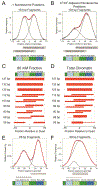Transcription and Remodeling Produce Asymmetrically Unwrapped Nucleosomal Intermediates
- PMID: 29225036
- PMCID: PMC6421108
- DOI: 10.1016/j.molcel.2017.11.015
Transcription and Remodeling Produce Asymmetrically Unwrapped Nucleosomal Intermediates
Abstract
Nucleosomes are disrupted during transcription and other active processes, but the structural intermediates during nucleosome disruption in vivo are unknown. To identify intermediates, we mapped subnucleosomal protections in Drosophila cells using Micrococcal Nuclease followed by sequencing. At the first nucleosome position downstream of the transcription start site, we identified unwrapped intermediates, including hexasomes that lack either proximal or distal contacts. Inhibiting topoisomerases or depleting histone chaperones increased unwrapping, whereas inhibiting release of paused RNAPII or reducing RNAPII elongation decreased unwrapping. Our results indicate that positive torsion generated by elongating RNAPII causes transient loss of histone-DNA contacts. Using this mapping approach, we found that nucleosomes flanking human CTCF insulation sites are similarly disrupted. We also identified diagnostic subnucleosomal particle remnants in cell-free human DNA data as a relic of transcribed genes from apoptosing cells. Thus identification of subnucleosomal fragments from nuclease protection data represents a general strategy for structural epigenomics.
Keywords: cell-free DNA; hexasome; structural epigenomics; subnucleosome; torsional strain; transcription elongation.
Copyright © 2017 Elsevier Inc. All rights reserved.
Figures







References
-
- Arimura Y, Tachiwana H, Oda T, Sato M, and Kurumizaka H (2012). Structural analysis of the hexasome, lacking one histone H2A/H2B dimer from the conventional nucleosome. Biochem 51, 3302–3309. - PubMed
-
- Azegami N, Saikusa K, Todokoro Y, Nagadoi A, Kurumizaka H, Nishimura Y, and Akashi S (2013). Conclusive evidence of the reconstituted hexasome proven by native mass spectrometry. Biochem 52, 5155–5157. - PubMed
-
- Baer BW, and Rhodes D (1983). Eukaryotic RNA polymerase II binds to nucleosome cores from transcribed genes. Nature 301, 482–488. - PubMed
-
- Bondarenko VA, Steele LM, Ujvari A, Gaykalova DA, Kulaeva OI, Polikanov YS, Luse DS, and Studitsky VM (2006). Nucleosomes can form a polar barrier to transcript elongation by RNA polymerase II. Mol Cell 24, 469–479. - PubMed
-
- Bortvin A, and Winston F (1996). Evidence that Spt6p controls chromatin structure by a direct interaction with histones. Science 272, 1473–1476. - PubMed
Publication types
MeSH terms
Substances
Grants and funding
LinkOut - more resources
Full Text Sources
Other Literature Sources
Molecular Biology Databases

